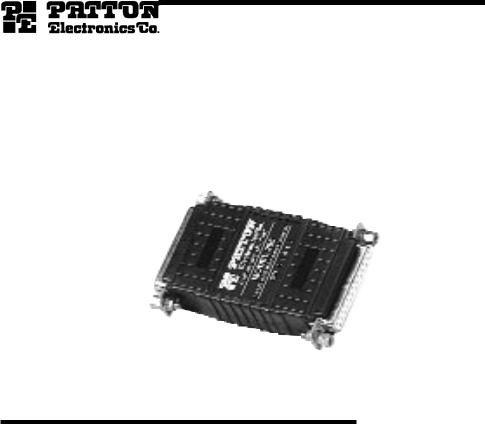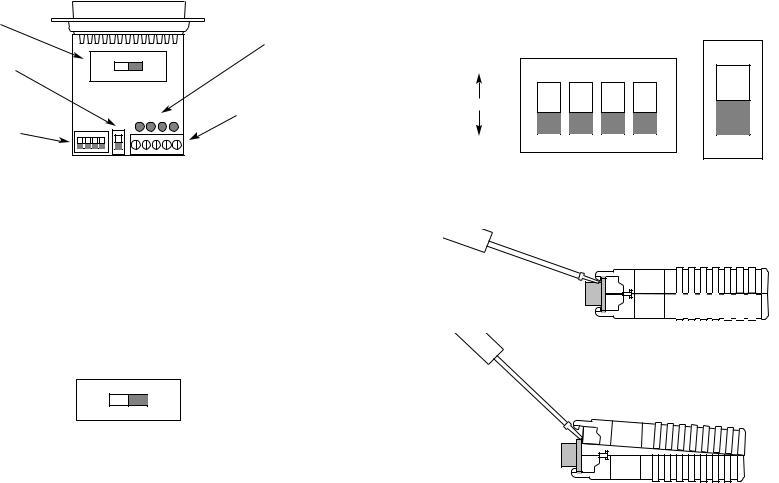Patton electronic 285, RS-232, 285S, RS-485 User Manual

USER MANUAL
MODEL 285 and 285S
RS-232 to RS-485 Interface Converters
Revision C and above
Part# 07M285-B
Doc# 047012UB
Revised 9/29/93
SALES OFFICE (301) 975-1000
TECHNICAL SUPPORT (301) 975-1007 http://www.patton.com
1.0 WARRANTY INFORMATION
Patton Electronics warrants all Model 285 components to be free from defects, and will—at our option—repair or replace the product should it fail within one year from the first date of shipment.
This warranty is limited to defects in workmanship or materials, and does not cover customer damage, abuse, or unauthorized modification. If this product fails or does not perform as warranted, your sole recourse shall be repair or replacement as described above. Under no condition shall Patton Electronics be liable for any damages incurred by the use of this product. These damages include, but are not limited to, the following: lost profits, lost savings, and incidental or consequential damages arising from the use of or inability to use this product. Patton Electronics specifically disclaims all other warranties, expressed or implied, and the installation or use of this product shall be deemed an acceptance of these terms by the user.
1.1 RADIO AND TV INTERFERENCE
The Model 285 generates and uses radio frequency energy, and if not installed and used properly—that is, in strict accordance with the manufacturer's instructions—may cause interference to radio and television reception. The Model 285 has been tested and found to comply with the limits for a Class A computing device in accordance with the specifications in Subpart J of Part 15 of FCC rules, which are designed to provide reasonable protection from such interference in a commercial installation. However, there is no guarantee that interference will not occur in a particular installation. If the Model 285 does cause interference to radio or television reception, which can be determined by disconnecting the RS-232 interface, the user is encouraged to try to correct the interference by one or more of the following measures: moving the computing equipment away from the receiver, re-orienting the receiving antenna, and/or plugging the receiving equipment into a different AC outlet (such that the computing equipment and receiver are on different branches).
1.2 SERVICE
All warranty and non-warranty repairs must be returned freight prepaid and insured to Patton Electronics. All returns must have a Return Materials Authorization number on the outside of the shipping container. This number may be obtained from Patton Electronics Technical Service at (301) 975-1007. Packages received without an RMA number will not be accepted.
Patton Electronics' technical staff is also available to answer any questions that might arise concerning the installation or use of your Model 285. Technical Service hours: 8AM to 5PM EST, Monday through Friday.
1
2.0 GENERAL INFORMATION
Thank you for your purchase of this Patton Electronics product. This product has been thoroughly inspected and tested and is warranted for One Year parts and labor. If any questions or problems arise during installation or use of this product, please do not hesitate to contact Patton Electronics Technical Support at (301) 975-1007.
2.1 FEATURES
•Bi-directionally converts RS-232 signals to balanced RS-485
•Supports up to 50 multipoint device drops in a polling environment
•Supports data rates to 115.2 Kbps on 2 or 4 wires
•Passes transmit & receive data, one control signal each direction
•DTE/DCE switch selectable on RS-232 interface
•Interface powered—no AC power or batteries are required
•Variable high/low impedance settings
•Carrier can be set as "constantly on" or "controlled by RTS"
2.2 DESCRIPTION
Communicate between RS-485 devices and RS-232C using the Patton Electronics Model 285 Interface Converter. The Model 285 converts RS-232C signals into balanced RS-485 signals over one or two twisted pair. Drawing all necessary operating power from the RS-232 interface, the Model 285 needs no AC power or batteries.
The Model 285 has six convenient configuration switches to adapt the unit for DCE or DTE, 2 or 4 wire, full or half duplex, and point-to- point or multi-point applications. The Model 285 will support up to 50 polled devices without distance degradation.
The surge protected Model 285S uses high speed avalanche diodes to clamp voltage surges caused by lightning, motors, switches, etc. With surge handling capacity of 600W per wire at 1mS, the 285S has the ability to protect itself and connected equipment from common damaging surges.
Connector options to the RS-485 are via DB-25 (employing the RS-530 interface), RJ-11, RJ-45, or terminal blocks with strain relief.
2

3.0 CONFIGURATION
The Model 285 is configured using six PC board mounted switches. Figure 1 (below) shows the switch locations, along with the location of the terminal blocks and optional surge protectors:
DCE/DTE
Switch Surge
Suppressors
(285S only)
2-wire/4-wire Switch
Terminal
Block
Control
Switches
Figure 1. Model 285 board, showing switch locations
3.1 SETTING THE DTE/DCE SWITCH
For your convenience, the Model 285 has an externally accessible DTE/DCE switch (see Figure 2, below). If the device connected to the Model 285 is a modem or multiplexer (or is wired like one), set the switch to "DTE". This setting causes the Model 285 to behave like Data Terminal Equipment and transmit data on pin 2.
If the device connected to the Model 285 is a PC, terminal or host computer (or is wired like one), set the switch to "DCE". This setting causes the Model 285 to behave like Data Communications Equipment and transmit data on pin 3.
DCE DTE
Figure 2. Close up of external DCE/DTE switch
3.2 SETTING CONFIGURATION SWITCHES SW1 AND SW2
The five switches shown in Figure 3 (below) configure the Model 285 for RTS/CTS delay, echo, method of carrier control, impedance, and 2-wire/4-wire operation. These switches are located internally on the Model 285's PC board. To access SW1 and SW2, use a small flat blade screw driver to pop open the Model 285's case as shown in Figure 4 (below):
"ON"
"OFF"
SW1 |
SW2 |
Figure 3. Close up of switches SW1 and SW2 on the PC board
Figure 4. Opening the Model 285's plastic case with a small screw driver
3 |
4 |
